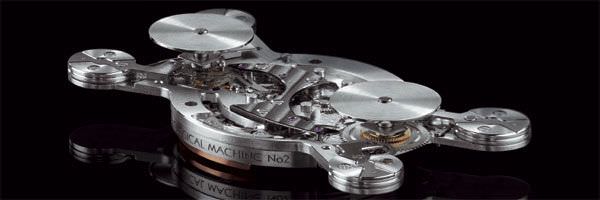Where does our never-ending fascination for ‘machines’ come from? This attraction holds true for all machines, large and small, locomotives or missiles, super-sophisticated computers or simple spring-operated toys?
Basically, isn’t it simply one’s own self that we love and admire in these machines? Isn’t this fascination tied to the ability to see, or even to glimpse, our own functioning, an idealized functioning because, if the machine is well made, it works to perfection, while us humans are always working in varying degrees of imperfection? But this functioning is also terribly simplified because a machine will execute a rational programme for which it has been designed. It does nothing else. A machine does not diverge from its task. It does not exit its programme to wander off. A machine does not invent anything. It feels no pleasure, no joy, no pain. A machine will not revolt. It deteriorates, and it stops. That’s all.

Horological Machine N02 by MB&F
“I consider man…to be like a clock composed of gears and counterweights,” said the ‘mechanist’ philosopher, Descartes. In this man-clock, the brain is the ‘mainspring’. And, if man has always seen his own image in the machine, he has also unceasingly tried to design machines in man’s image.
A very astute ‘engineer’ of the era, Vaucanson, claimed as being the ‘rival of Prometheus’ by Voltaire, created the ‘Digesting Duck’ in 1739, ‘an artificial duck in gilded copper that drinks, eats, quacks, paddles in the water, and digests its food like a living duck. Thanks to the transparency of its abdomen, spectators could even follow the digestive process from the gullet to the sphincter that expulsed a sort of green paste’. A little closer to our time, the Belgian artist, Wim Delevoye, with his ‘Cloaca’ machine that fascinated scientists, succeeded in reproducing the entire digestive system step by step. But his machine, which had to be fed like a man and which produced human waste, however sophisticated it was, remained like all machines, a ‘bachelor machine’, meaning that it worked only by itself and for itself. And, today’s nanotechnologies seem to promise to transform us into man-machines little by little.
But is that really our future? What differentiates us humans from machines is that we are not ‘bachelor machines’. When we cease to function for and with others, when we become a ‘bachelor machine’, we become crazed or criminal. Why, then, do we continue to be so fascinated by machines, especially the small ‘bachelor machines’ in gold or platinum that tick away on our wrists?
It is because they are our mirror, a partial mirror, enlarging or deforming, a broken mirror, a fraction of a mirror, or a sparkle of a mirror that reflects, in part, our own image. It is not so much the machines themselves, but it is a part of ourselves that we love in our ‘horological machines’.
Source: Europa Star April-May 2007 Magazine Issue





